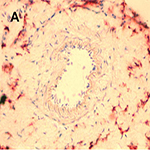Temporal patterns of blood flow and nitric oxide synthase expression affect macrophage accumulation and proliferation during collateral growth
Main Article Content
Abstract
Background
The involvement of collateral blood flow/fluid shear stress, nitric oxide (NO), and macrophages during collateral growth (arteriogenesis) is established, but their interplay remains paradoxical.Methods
In order to further elucidate the "fluid shear stress/NO/macrophage" paradox, we investigated the time course of collateral blood flow (using a Doppler flow probe) and NOS expression (immunohistochemistry, Western blot) in growing rat collateral vessels after femoral artery occlusion and their impact on macrophage recruitment and collateral proliferation (immunohistochemistry, angiographies).Results
(values are given as mean ± standard error of mean) Early after occlusion, collateral blood flow was significantly reduced (pre- 90.0 ± 4.5 vs. post-occlusion 62.5 ± 5.9 μl/min; p< 0.01), and local inducible NOS (iNOS) and endothelial NOS (eNOS) expression were down-regulated (expression in % of non-occluded: eNOS 49.4 ± 11.8% and iNOS 54.5 ± 7.9% vs. non-occluded at 12 h after occlusion; p< 0.03). An artificial rise (induced by a peripheral vasodilatation) of the initially decreased collateral blood flow back to pre-occlusion levels reduced collateral macrophage recruitment (macrophages per collateral section: post- 42.5 ± 4.4 vs. artificial pre-occlusion 27.8 ± 2.0; p< 0.05) and diminished collateral proliferation (proliferative index: post- 0.54 ± 0.02 vs. artificial pre-occlusion 0.19 ± 0.04; p< 0.001) significantly 72 h after femoral artery occlusion.
Conclusions
We propose the following resolution of the "fluid shear stress/NO/macrophage" paradox: Collateral blood flow and NOS expression are initially reduced during arteriogenesis allowing macrophages to accumulate and therewith enhancing collateral proliferation. After homing of macrophages (24 h after occlusion), collateral blood flow and NOS expression recover in order to join the effects of macrophages for restoring blood flow.Article Details
How to Cite
SAGER, Hendrik B et al.
Temporal patterns of blood flow and nitric oxide synthase expression affect macrophage accumulation and proliferation during collateral growth.
Vascular Cell, [S.l.], v. 2, n. 1, p. 18, sep. 2010.
ISSN 2045-824X.
Available at: <https://vascularcell.com/index.php/vc/article/view/10.1186-2040-2384-2-18>. Date accessed: 22 jan. 2026.
doi: http://dx.doi.org/10.1186/2040-2384-2-18.
Section
Original Research

